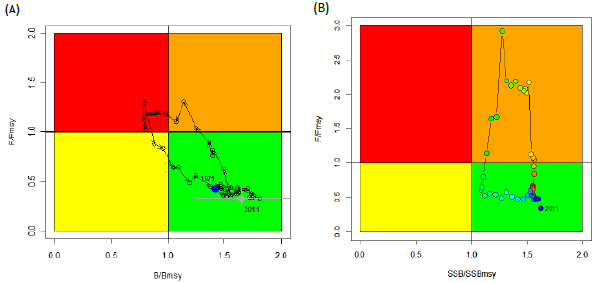Stock Status and Conservation Advice
(From ISC16 Plenary Report)
Blue shark
Stock Status
Median stock biomass of Blue Shark in 2011 (B2011) was estimated to be 622,000 t using a Bayesian surplus production (BSP) model and median annual fishing mortality in 2011 (F2011) was approximately 32% of FMSY (Figure 1). Female spawning stock biomass of blue shark in 2011 (SSB2011) was estimated to be 449,930 t using a Stock Synthesis (SS) model and the estimate of F2011 was approximately 34% of FMSY. Target and limit reference points have not yet been established for pelagic sharks in the Pacific.
Relative to MSY, the majority of BSP and SS models run with input parameter values considered more probable based on the biology of blue sharks support the conclusion that the North Pacific blue shark stock is not overfished and overfishing is not occurring. Kobe plots showing the trajectories for the reference runs are shown in Figure 1.

- Kobe plot showing median biomass and fishing mortality trajectories for the reference case Bayesian Surplus Production model for North Pacific BSH. Solid blue circle indicates the median estimate in 1971 (initial year of the model). Solid gray circle and its horizontal and vertical bars indicate the median and 90% confidence limits in 2011. Open black circles and black arrows indicate the historical trajectory of stock status between 1971 and 2011.
- Kobe plot showing estimated spawning biomass and fishing mortality trajectories for the reference case Stock Synthesis model for North Pacific BSH. The circles indicate the historical trajectory from 1971-2011 colored from red (first year) to blue (terminal year).
While the results of the sensitivity runs varied depending upon the input assumptions, a few parameters were most influential on the results, including the CPUE series selected as well as the shape parameters for the BSP models and the equilibrium initial catch and form of the low fecundity stock recruitment relationship for the SS models.
Conservation Advice
Future projections of the reference case models show that median BSH biomass in the North Pacific will remain above BMSY and SSBMSY under the catch harvest policies examined (status quo, +20%, -20%). Similarly, future projections under different fishing mortality (F) harvest policies (status quo, +20%, -20%) show that median blue shark biomass in the North Pacific BSH will likely remain above BMSY and SSBMSY.
Given uncertainties regarding the estimated catch and choice of input parameters for the assessment, the catch of and fishing effort on BSH should be carefully monitored. Carefully designed observer programs and logbooks that record sharks by species as well as continued research into the fisheries, biology, and ecology of BSH in the North Pacific are recommended to make improvements prior to the next assessment which is scheduled for 2017.